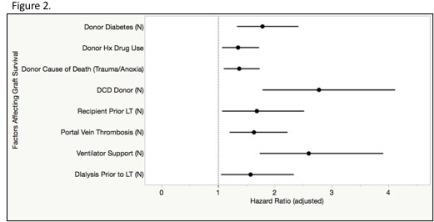Predictors of Graft Survival amongst Recipients of Liver Allografts with Prolonged Cold Ischemic Time (CIT)
1Surgery, Cedars-Sinai Medical Center, Los Angeles, CA
2Surgery, Oregon Health Science University, Portland, OR.
Meeting: 2018 American Transplant Congress
Abstract number: A259
Keywords: Donors, Graft failure, Liver transplantation, marginal
Session Information
Session Name: Poster Session A: Liver: MELD, Allocation and Donor Issues (DCD/ECD)
Session Type: Poster Session
Date: Saturday, June 2, 2018
Session Time: 5:30pm-7:30pm
 Presentation Time: 5:30pm-7:30pm
Presentation Time: 5:30pm-7:30pm
Location: Hall 4EF
Background: CIT is an independent risk factor for worse outcomes in liver transplantation (LT). Factors contributing to improved graft survival in organs with CIT ≥12 hours were evaluated and may prove beneficial when considering organ offers with prolonged CIT.
Methods: The UNOS STAR database contained 60,200 LT between July 2006 and June 2013. 1,560 with CIT ≥12h were evaluated for donor, recipient and procurement characteristics. Univariate and multivariate Cox proportional hazards analyses identified factors contributing to graft survival. Kaplan-Meier (KM) survival analysis was performed.
Results: Time to 25% failure in organs with CIT ≥12h was 899 days compared to 1450 days when CIT <12h (p<0.0001). After controlling for recipient age, MELD, and liver disease etiology, improved graft survival after CIT ≥12h was associated with non-diabetic donors (HR=0.74, p<0.001), donor history of drug use (HR=0.86, p=0.01), donor cause of death secondary to trauma/anoxia (HR=0.78, p=0.005), and heart-beating donor (HR=0.60, p<0.001). Favorable recipient factors include first-time LT recipients (HR=0.77, p=0.02), absence of portal vein thrombosis (HR=0.78, p=0.002), and patients without dialysis requirement (HR=0.80, p<0.001) or ventilator support (HR=0.62, p<0.001).  KM-analysis estimated graft survival from 30-days to 3-years.
KM-analysis estimated graft survival from 30-days to 3-years.  Common causes of graft loss amongst recipients of organs with CIT ≥12h were primary graft failure (33.7%) and vascular thrombosis (13.7%).
Common causes of graft loss amongst recipients of organs with CIT ≥12h were primary graft failure (33.7%) and vascular thrombosis (13.7%).
Conclusion: Understanding the factors which contribute to improved outcomes despite extended CIT ≥12h may reduce the discard rate of livers with prolonged CIT and expand the donor pool.
CITATION INFORMATION: Steggerda J., Kim K., Malinoski D., Bloom M. Predictors of Graft Survival amongst Recipients of Liver Allografts with Prolonged Cold Ischemic Time (CIT) Am J Transplant. 2017;17 (suppl 3).
To cite this abstract in AMA style:
Steggerda J, Kim K, Malinoski D, Bloom M. Predictors of Graft Survival amongst Recipients of Liver Allografts with Prolonged Cold Ischemic Time (CIT) [abstract]. https://atcmeetingabstracts.com/abstract/predictors-of-graft-survival-amongst-recipients-of-liver-allografts-with-prolonged-cold-ischemic-time-cit/. Accessed December 22, 2025.« Back to 2018 American Transplant Congress
